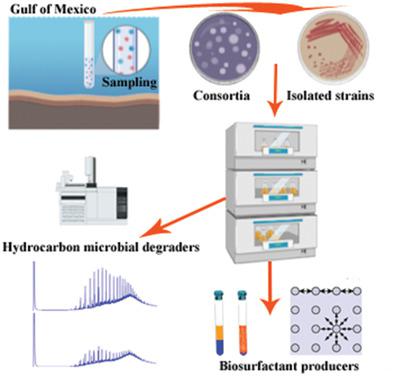当前位置:
X-MOL 学术
›
Biotechnol. Appl. Bioc.
›
论文详情
Our official English website, www.x-mol.net, welcomes your feedback! (Note: you will need to create a separate account there.)
Microbial prospection of communities that produce biosurfactants from the water column and sediments of the Gulf of Mexico
Biotechnology and Applied Biochemistry ( IF 2.8 ) Pub Date : 2020-09-24 , DOI: 10.1002/bab.2042 Daniel Morales-Guzmán 1 , Fernando Martínez-Morales 1 , Brandt Bertrand 2 , Nashbly Sarela Rosas-Galván 1 , Nidya Fabiola Curiel-Maciel 1 , Karla Verónica Teymennet-Ramírez 1 , Luis Enrique Mazón-Román 1 , Alexei Fedorovish Licea-Navarro 3 , María R Trejo-Hernández 1
Biotechnology and Applied Biochemistry ( IF 2.8 ) Pub Date : 2020-09-24 , DOI: 10.1002/bab.2042 Daniel Morales-Guzmán 1 , Fernando Martínez-Morales 1 , Brandt Bertrand 2 , Nashbly Sarela Rosas-Galván 1 , Nidya Fabiola Curiel-Maciel 1 , Karla Verónica Teymennet-Ramírez 1 , Luis Enrique Mazón-Román 1 , Alexei Fedorovish Licea-Navarro 3 , María R Trejo-Hernández 1
Affiliation

|
Microbial communities capable of hydrocarbon degradation linked to biosurfactant (BS) and bioemulsifier (BE) production are basically unexplored in the Gulf of México (GOM). In this work, the BS and BE production of culturable marine bacterial hydrocarbonoclasts consortia isolated from two sites (the Perdido Fold Belt and Coatzacoalcos area) was investigated. The prospection at different locations and depths led to the screening and isolation of a wide variety of bacterial consortia with BS and BE activities, after culture enrichment with crude oil and glycerol as the carbon sources. At least 55 isolated consortia presented reduction in surface tension (ST) and emulsifying activity (EI24). After colony purification, bacteria were submitted to polyphasic analysis assays that resulted in the identification of different strains of cultivable Gammaproteobacteria Gram (−) Citrobacter, Enterobacter, Erwinia, Pseudomonas, Vibrio, Shewanella, Thalassospira, Idiomarina, Pseudoalteromonas, Photobacterium, and Gram (+) Staphylococcus, Bacillus, and Microbacterium. Overall, the best results for ST reduction and EI24 were obtained with consortia. Individually, Pseudomonas, Bacillus, and Enterobacter strains showed the best results for the reduction of ST after 6 days, while Thalassospira and Idiomarina strains showed the best results for EI24 (above 68% after 9 days). Consortia isolates from the GOM had the ability to degrade crude oil by up to 40–80% after 24 and 36 months, respectively. In all cases, biodegradation of crude oil was related to the reduction in ST and bioemulsifying activity and was independent from the depth in the water column.
中文翻译:

从墨西哥湾的水柱和沉积物中生产生物表面活性剂的群落的微生物勘探
与生物表面活性剂 (BS) 和生物乳化剂 (BE) 生产相关的能够降解碳氢化合物的微生物群落在墨西哥湾 (GOM) 基本上是未开发的。在这项工作中,研究了从两个地点(Perdido 褶皱带和 Coatzacoalcos 地区)分离的可培养海洋细菌破氢菌群的 BS 和 BE 生产。在以原油和甘油为碳源进行富集培养后,不同位置和深度的勘探导致筛选和分离出多种具有BS和BE活性的细菌聚生体。至少 55 个分离的联合体表现出表面张力 (ST) 和乳化活性 (EI 24 ) 降低)。菌落纯化后,对细菌进行多相分析分析,从而鉴定出不同的可培养 Gammaproteobacteria Gram (−) Citrobacter、Enterobacter、Erwinia 、 Pseudomonas 、 Vibrio、Shewanella、Thalassospira 、 Idiomarina 、 Pseudoalteromonas 、 Photobacterium和 Gram (+ )葡萄球菌、芽孢杆菌和微杆菌。总体而言,联合体获得了ST 减少和 EI 24的最佳结果。分别为假单胞菌属、芽孢杆菌属和肠杆菌属菌株在 6 天后降低 ST 的效果最好,而Thalassospira和Idiomarina菌株对 EI 24的效果最好(9 天后超过 68%)。在 24 个月和 36 个月后,从 GOM 中分离出的聚生菌分别能够将原油降解高达 40-80%。在所有情况下,原油的生物降解都与 ST 和生物乳化活性的降低有关,并且与水柱的深度无关。
更新日期:2020-09-24
中文翻译:

从墨西哥湾的水柱和沉积物中生产生物表面活性剂的群落的微生物勘探
与生物表面活性剂 (BS) 和生物乳化剂 (BE) 生产相关的能够降解碳氢化合物的微生物群落在墨西哥湾 (GOM) 基本上是未开发的。在这项工作中,研究了从两个地点(Perdido 褶皱带和 Coatzacoalcos 地区)分离的可培养海洋细菌破氢菌群的 BS 和 BE 生产。在以原油和甘油为碳源进行富集培养后,不同位置和深度的勘探导致筛选和分离出多种具有BS和BE活性的细菌聚生体。至少 55 个分离的联合体表现出表面张力 (ST) 和乳化活性 (EI 24 ) 降低)。菌落纯化后,对细菌进行多相分析分析,从而鉴定出不同的可培养 Gammaproteobacteria Gram (−) Citrobacter、Enterobacter、Erwinia 、 Pseudomonas 、 Vibrio、Shewanella、Thalassospira 、 Idiomarina 、 Pseudoalteromonas 、 Photobacterium和 Gram (+ )葡萄球菌、芽孢杆菌和微杆菌。总体而言,联合体获得了ST 减少和 EI 24的最佳结果。分别为假单胞菌属、芽孢杆菌属和肠杆菌属菌株在 6 天后降低 ST 的效果最好,而Thalassospira和Idiomarina菌株对 EI 24的效果最好(9 天后超过 68%)。在 24 个月和 36 个月后,从 GOM 中分离出的聚生菌分别能够将原油降解高达 40-80%。在所有情况下,原油的生物降解都与 ST 和生物乳化活性的降低有关,并且与水柱的深度无关。



























 京公网安备 11010802027423号
京公网安备 11010802027423号